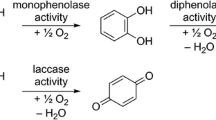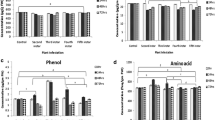Abstract
Ascorbic acid is essential for both nutritive and antioxidant functions in phytophagous insects; however, maintaining sufficient quantities of reduced ascorbate may be problematical for them. In this investigation, we show that the plant enzyme ascorbate oxidase retains activity in the digestive system of the herbivoreHelicoverpa zea. High levels of the enzyme are present in several host plants ofH. zea, including cotton, tomato, soybean, crimson clover, and vetch. The enzyme oxidizesL-ascorbic acid to dehydro-L-ascorbic acid, a potentially toxic product. The oxidation of ascorbic acid also produces active oxygen species such as the highly reactive hydroxyl radical. The nutritional quality of protein for larvalH. zea was significantly reduced by treatment with ascorbate and ascorbate oxidase. Oxidative damage to the protein was indicated by decreased lysine content, increased carbonyl formation, and the occurrence of protein fragmentation and polymerization. Furthermore, the oxidative loss of ascorbate in the herbivore's digestive system prevents ascorbate from functioning as an important antioxidant against a plethora of dietary prooxidants.
Similar content being viewed by others
References
Adam, A., Farkas, T., Somlyai, G., Hevesi, M., andKiraly, Z. 1989. Consequences of O −2 generation during a bacterially induced hypersensitive reaction in tobacco: Deterioration of membrane lipids.Physiol. Mol. Plant Pathol. 34:13–26.
Baysal, E., Sullivan, S.G., andStern, A. 1989. Prooxidant and antioxidant effects of ascorbate on tBuOOH-induced erythrocyte membrane damage.Int. J. Biochem. 21:1109–1113.
Bianchi, J., andRose, R.C. 1986. Dehydroascorbic acid and cell membranes: Possible disruptive effects.Toxicology 40:75–82.
Bol, J.F., Linthorst, H.J.M., andCornelissen, B.J.C. 1990. Plant pathogenesis-related proteins induced by virus infection.Annu. Rev. Phytopathol. 28:113–138.
Bowles, D.J. 1990. Defense-related proteins in higher plants.Annu. Rev. Biochem. 59:873–907.
Broadway, R.M., andDuffey, S.S. 1986. The effect of dietary protein on the growth and digestive physiology of larvalHeliothis zea andSpodoptera exigua.J. Insect Physiol. 32:673–680.
Bruins, B.G., Scharloo, W., andThorig, G.W. 1991. Dietary ascorbic acid, pyridoxine and riboflavin reduce the light sensitivity of larvae and pupae ofDrosophila melanogaster.Insect Biochem. 21:541–544.
Cakmak, I., andMarschner, H. 1992. Magnesium deficiency and high light intensity enhance activities of Superoxide dismutase, ascorbate peroxidase, and glutathione reductase in bean leaves.Plant Physiol. 98:1222–1227.
Chiou, S. 1984. DNA-scission activities of ascorbate in the presence of metal chelates.J. Biochem. 96:1307–1310.
Chippendale, G.M. 1970. Metamorphic changes in fat body proteins of the southwestern corn borerDiatraea grandiosella.J. Insect Physiol. 16:1057–1068.
Chrispeels, M.J., andRaikhel, N.V. 1991. Lectins, lectin genes, and their role in plant defense.Plant Cell 3:1–9.
Clemetson, C.A.B. 1989. Vitamin C, Vol. I. CRC Press, Boca Raton, Florida, 318 pp.
Dadd, R.H. 1985. Nutrition: organisms, pp. 313–390,in G.A. Kerkut and L.I. Gilbert (eds.) Comprehensive Insect Physiology, Biochemistry, and Pharmacology, Vol. 4. Pergamon Press, Oxford, England.
Dalton, D.A., Russell, S.A., Hanus, F.J., Pascoe, G.A., andEvans, H.J. 1986. Enzymatic reactions of ascorbate and glutathione that prevent peroxide damage in soybean root nodules.Proc. Natl. Acad. Sci. U.S.A. 83:3811–3815.
Dean, J.F.D., andEriksson, K.L. 1992. Biotechnological modifications of lignin structure and composition in forest trees.Holzforschung 46:135–147.
Duffey, S.S., andFelton, G.W. 1991. Enzymatic antinutritive defenses of the tomato plant against insects, pp. 166–197,in P.A. Hedin (ed.). Naturally Occurring Pest Bioregulators. American Chemical Society, Washington, D.C., 456 pp.
Dunn, B.M. 1989. Determination of protease mechanism, pp. 57–82,in R.J. Beynon and J.S. Bond (eds.). Proteolytic Enzymes-A Practical Approach. IRL Press, Oxford, 259 pp.
Englard, S., andSeifter, S. 1986. The biochemical functions of ascorbic acid.Annu. Rev. Nutr. 6:365–406.
Esaka, M., Nishitani, I., Fukui, H., Suzuki, K., andKubota, K. 1989. Stimulation of ascorbate oxidase secretion from cultured pumpkin cells by divalent cations.Phytochemistry 28:2655–2658.
Felton, G.W., andDuffey, S.S. 1992. Ascorbate oxidation reduction inHelicoverpa zea as a scavenging system against dietary oxidants.Arch. Insect Biochem. Physiol. 19:27–37.
Felton, G.W., Donato, K., Del Vecchio, R.J., andDuffey, S.S. 1989. Activation of plant foliar oxidases by insect feeding reduces the nutritive quality of foliage for noctuid herbivores.J. Chem. Ecol. 15:2667–2694.
Felton, G.W., Donato, K., Broadway, R.M., andDuffey, S.S. 1992. Impact of oxidized plant phenolics on the nutritional quality of dietary protein to a noctuid herbivore.J. Insect Physiol. 38:277–285.
Fields, R. 1972. The rapid determination of amino groups with TNBS.Methods Enzymol. 25B:464–468.
Fleming, J.E., andBensch, K.G. 1983a. Effect of amino acids, peptides, and related compounds on the autooxidation of ascorbic acid.Int. J. Pept. Protein Res. 22:355–361.
Fleming, J.E., andBensch, K.G. 1983b. Conformational changes of serum albumin induced by ascorbic acid.Int. J. Pept. Protein Res. 22:565–567.
Frei, B., England, L., andAmes, B.N. 1989. Ascorbate is an outstanding antioxidant in human blood plasma.Proc. Natl. Acad. Sci. U.S.A. 86:6377–6381.
Halliwell, B., Grootveld, M., andGutteridge, J.M.C. 1987a. Methods for the measurement of hydroxyl radical in biochemical systems: Deoxyribose degradation and aromatic hydroxylation.Methods Biochem. Anal. 33:59–90.
Halliwell, B., Gutteridge, J.M.C., andArouma, O.I. 1987b. The deoxyribose method: A simple ▿est tube” assay for the determination of rate constants for reactions of hydroxyl radicals.Anal. Biochem. 165:215–219.
Hildebrand, D.F., Hamilton-Kemp, T.R., Legg, C.S., andBookjans, G. 1988. Plant lipoxygenases: Occurrence, properties and possible functions.Curr. Top. Plant Biochem. Physiol. 7:201–219.
Janovitz-Klapp, A.H., Richard, F.C., Goupy, P.M., andNicolas, J.J. 1990. Inhibition studies on apple polyphenol oxidase.J. Agric. Food Chem. 38:926–931.
Kramer, K.J., andSeib, P.A. 1982. Ascorbic acid and the growth and development of insects, pp. 275–291,in P.A. Seib and B.M. Tolbert (eds.). Ascorbic Acid: Chemistry, Metabolism, and Uses. American Chemical Society, Washington, D.C.
Law, M.Y., Charles, S.A., andHalliwell, B. 1983. Glutathione and ascorbic acid in spinach (Spinacia oleracea) chloroplasts. The effect of hydrogen peroxide and paraquat.Biochem. J. 210:899–903.
Lee, E.H. 1991. Plant resistance mechanisms to air pollutants: rhythms in ascorbic acid production during growth under ozone stress.Chronobiol. Int. 8:93–102.
Lenz, C.J., Kang, J., Rice, W.C., McIntosh, A.H., Chippendale, G.M., andSchubert, K.R. 1991. Digestive proteinases of larvae of the corn earworm,Heliothis zea: characterization, distribution, and dietary relationships.Arch. Insect Biochem. Physiol. 16:201–212.
Levine, R.L., Garland, D., Oliver, C.N., Amici, A., Climent, U.I., Lenz, A., Ahn, B., Shaltiel, S., andStadtman, E.R. 1990. Determination of carbonyl content in oxidatively modified proteins.Methods Enzymol. 186:464–502.
Lin, L., andVarner, J.E. 1991. Expression of ascorbic acid oxidase in zucchini squash (Cucurbita pepo L.).Plant Physiol. 96:159–165.
Mohri, S., Endo, Y., Matsuda, K., Kitamura, K., andFujimoto, K. 1990. Physiological effects of soybean seed lipoxygenases on insects.Agric. Biol. Chem. 54:2265–2270.
Rose, R.C., Coi, J., andBode, A.M. 1992. Short term effects of oxidized ascorbic acid on bovine corneal endothelium and human placenta.Life Sci. 50:1543–1549.
Ryan, C.A. 1990. Protease inhibitors in plants: Genes for improving defenses against insects and pathogens.Annu. Rev. Phytopathol. 28:425–449.
Shukle, R.H., andMurdock, L.L. 1983. Lipoxygenase, trypsin inhibitor, and lectin from soybean: Effects on the larval growth ofManduca sexta (Lepidoptera: Sphingidae).Environ. Entomol. 12:787–791.
Slight, S.H., Feather, M.S., andOrtwerth, B.J. 1990. Glycation of lens proteins by the oxidation products of ascorbic acid.Biochim. Biophys. Acta. 1038:367–374.
Stoschek, C.M. 1990. Increased uniformity in the response of the Coomassie blue G protein assay to different proteins.Anal. Biochem. 184:111–116.
Summers, C.B., andFelton, G.W. 1993. Antioxidant role of dehydroascorbic acid reductase in insects.Biochim. Biophys. Acta 1156:235–238.
Takahama, U., andOniki, T. 1992. Regulation of peroxidase-dependent oxidation of phenolics in the apoplast of spinach leaves by ascorbate.Plant Cell Physiol. 33:379–387.
Tolbert, B.M., andWard, J.B. 1982. Dehydroascorbic acid, pp. 101–123,in P.A. Seib and B.M. Tolbert (eds.). Ascorbic Acid: Chemistry, Metabolism, and Uses. American Chemical Society, Washington, D.C.
Uchida, K., Enomoto, N., Itakura, K., andKawakishi, S. 1989. The hydroxyl radical generated by an iron(II)/EDTA/ascorbate system preferentially attacks tryptophan residues of the protein.Agric. Biol. Chem. 53:3285–3292.
Vanderzant, E.S., Pool, M.C., andRichardson, C.D. 1962. Ascorbic acid in nutrition ofAnthonomus andHeliothis.J. Insect Physiol. 8:287–297.
Wayner, D.M., Burton, G.W., andIngold, K.U. 1986. The antioxidant efficiency of vitamin C is concentration dependent.Biochim. Biophys. Acta 884:119–123.
Winkler, B.S. 1987. The in vitro oxidation of ascorbic acid and its prevention by GSH.Biochim. Biophys. Acta 925:258–264.
Author information
Authors and Affiliations
Rights and permissions
About this article
Cite this article
Felton, G.W., Summers, C.B. Potential role of ascorbate oxidase as a plant defense protein against insect herbivory. J Chem Ecol 19, 1553–1568 (1993). https://doi.org/10.1007/BF00984896
Received:
Accepted:
Issue Date:
DOI: https://doi.org/10.1007/BF00984896




